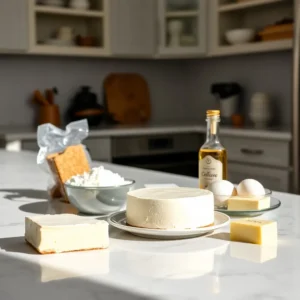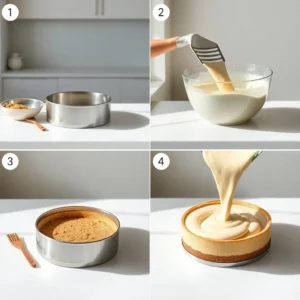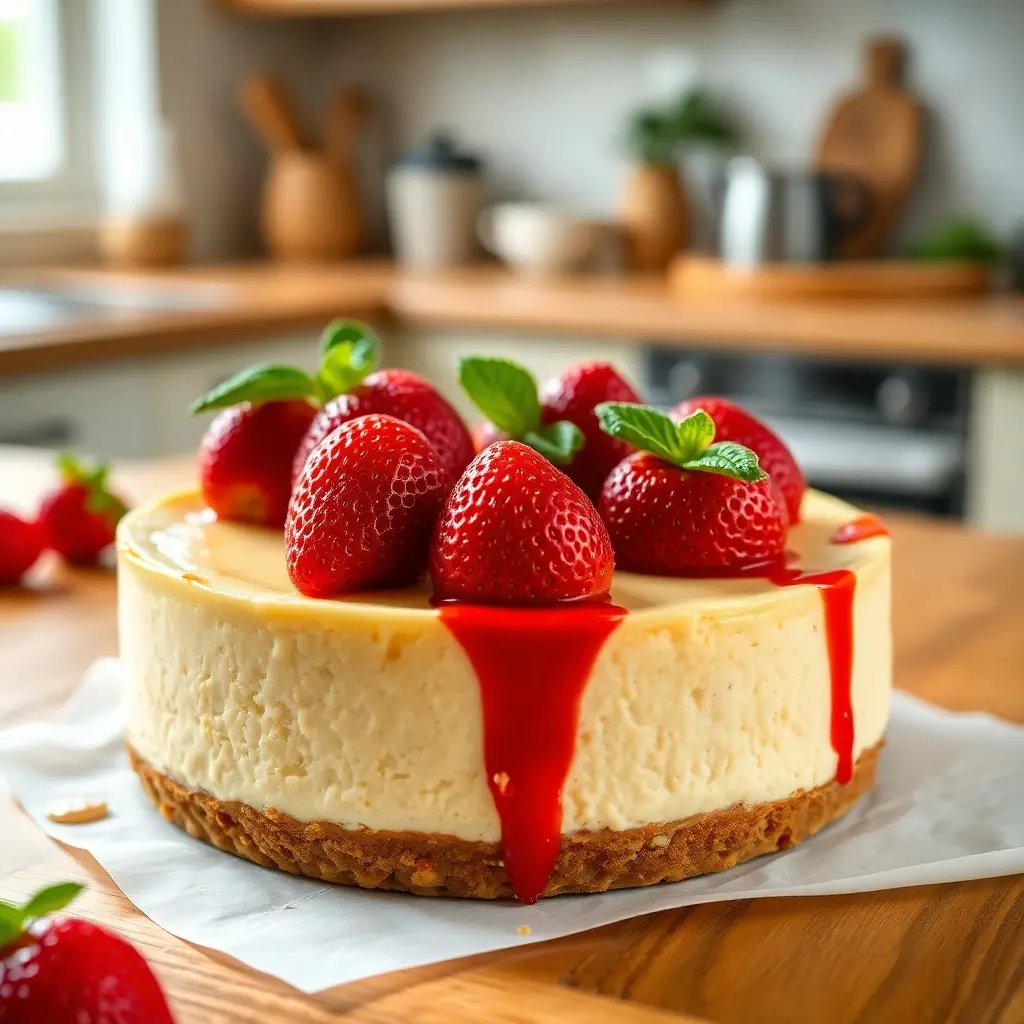Discover the secrets to crafting the most irresistible, creamy Philadelphia-style cheesecake from scratch. This recipe covers everything from selecting the perfect ingredients to mastering baking techniques. Whether you’re a novice or an experienced baker, you’ll find tips to ensure every slice is flawless.
Part 1: Introduction to Philadelphia Cheesecake
What is Philadelphia Cheesecake?
Philadelphia cheesecake is not just any cheesecake; it’s an iconic dessert renowned for its silky texture and rich flavor. Unlike other cheesecakes, this treat owes its luscious consistency to the use of high-quality cream cheese, making every bite creamy and decadent. But, where does the name come from? While Philadelphia cream cheese is a household name today, its origins can be traced back to the late 1800s, when it was marketed as the gold standard for cream cheese—hence, the association with this indulgent dessert.
Origins and History
This cheesecake draws inspiration from traditional European recipes but incorporates uniquely American twists, such as using graham cracker crusts. It became popular in the 1900s, thanks to Philadelphia’s prominence in dairy production. Today, it’s a global favorite, loved for its versatility and ease of customization.
Distinctive Features of Philadelphia-Style Cheesecake
What sets Philadelphia cheesecake apart? The magic lies in the texture—it’s denser and creamier than its New York-style counterpart. The use of full-fat cream cheese ensures that signature richness, while a balanced combination of eggs and sugar creates a slightly sweet, custard-like filling. Plus, the crust, often made with graham crackers, adds a delightful crunch that complements the creamy filling.
Why Choose Philadelphia Cream Cheese?
When it comes to cheesecake, not all cream cheeses are created equal. Philadelphia cream cheese has earned its reputation as the go-to choice for desserts. Why? It delivers unparalleled smoothness and a slightly tangy flavor, perfect for balancing sweetness.
Quality and Texture
The superior quality of Philadelphia cream cheese ensures a velvety texture, which is key to achieving that flawless cheesecake consistency. It’s versatile enough to blend seamlessly with other ingredients, yet firm enough to hold its structure when baked.
Brand Legacy and Trust
With over a century of expertise, Philadelphia cream cheese has become a staple in kitchens worldwide. Its reliability means you can trust it to elevate your cheesecake every time.
Part 2: Essential Ingredients and Equipment
Key Ingredients for Philadelphia Cheesecake
 When it comes to making a Philadelphia Cheesecake Recipe, choosing the right ingredients is critical. Not only do these components define the texture, but they also impact the overall flavor profile. Let’s break it down:
When it comes to making a Philadelphia Cheesecake Recipe, choosing the right ingredients is critical. Not only do these components define the texture, but they also impact the overall flavor profile. Let’s break it down:
- Cream Cheese Selection
To achieve that signature creaminess, always go for full-fat cream cheese. While Philadelphia cream cheese is the gold standard, you can explore other brands if necessary. Ensure it’s at room temperature before mixing to avoid lumps in the batter. - Crust Components
A traditional graham cracker crust forms the base of most cheesecakes. You’ll need finely crushed graham crackers, melted butter, and sugar to bind everything together. Alternatively, digestive biscuits or crushed cookies work wonders if you prefer a unique twist. - Sweeteners and Flavorings
Granulated sugar is the sweetener of choice for the filling. Vanilla extract adds depth to the flavor, while a dash of lemon juice brings a subtle tanginess that balances the richness of the cream cheese.
Recommended Equipment
Baking the perfect cheesecake isn’t just about ingredients; having the right tools can make the process seamless. You don’t need a professional kitchen setup, but a few essentials are non-negotiable.
- Springform Pan Alternatives
A springform pan is a must-have because it allows easy removal of the cheesecake without damaging its sides. However, if you don’t have one, a deep pie dish or a 9×13 pan can serve as substitutes. Taste of Home has a great guide on this (tasteofhome.com). - Mixing Tools and Techniques
A stand mixer or hand mixer works best for blending the cream cheese and sugar into a smooth batter. Avoid overmixing, as it can incorporate too much air, which might cause cracks during baking.
Part 3: Step-by-Step Preparation Guide
Preparing the Crust
 Creating the perfect crust is not only simple but also sets the foundation for your cheesecake. It provides a crunchy contrast to the smooth, creamy filling. Let’s get started:
Creating the perfect crust is not only simple but also sets the foundation for your cheesecake. It provides a crunchy contrast to the smooth, creamy filling. Let’s get started:
- Graham Cracker Crust Recipe
First, finely crush the graham crackers using a food processor or a resealable bag and rolling pin. Next, mix the crumbs with melted butter and sugar until they resemble wet sand. Press this mixture firmly into the bottom of your springform pan, ensuring an even layer. Finally, bake the crust at 350°F (175°C) for about 10 minutes. This step helps the crust hold its shape and prevents it from getting soggy. - Alternative Crust Options
If graham crackers aren’t your thing, try using crushed Oreos or digestive biscuits. Even almond flour mixed with butter can work for a gluten-free version! With so many options, there’s no need to stick to just one.
Crafting the Creamy Filling
This is where the magic happens! The filling is the star of the show, and getting it right ensures your cheesecake is smooth and luscious.
- Mixing Techniques for a Smooth Batter
Begin by beating the room-temperature cream cheese with sugar on medium speed until it’s completely smooth. Gradually add the eggs, one at a time, and ensure each is fully incorporated before adding the next. Toss in vanilla extract and a dash of lemon juice for that extra depth of flavor. - Incorporating Flavors and Add-ins
If you’re feeling adventurous, mix in a swirl of melted chocolate, caramel, or fruit puree. Be gentle when folding in these add-ins to avoid deflating the batter.
By combining the right techniques with patience, you’ll create a cheesecake filling that is both rich and velvety.
Part 4: Baking and Cooling Techniques
Optimal Baking Conditions
Once the crust and filling are ready, baking your Philadelphia Cheesecake Recipe with precision is the key to achieving that perfect texture. Although it might sound intimidating, following these steps ensures success.
- Temperature and Timing
Preheat your oven to 325°F (163°C), as a lower temperature helps the cheesecake bake evenly without cracking. Place the springform pan with your prepared crust and filling onto the middle oven rack. Bake for approximately 55–70 minutes, or until the edges are set but the center jiggles slightly when gently shaken. - Water Bath Method Explained
A water bath is a game-changer, especially if you’re aiming for a crack-free top. Simply wrap the outside of your springform pan with aluminum foil to prevent leaks, then place it into a larger baking dish filled with hot water. The steam created during baking maintains even moisture levels, preventing your cheesecake from drying out. For a detailed guide on water baths, check out Food Network’s Cheesecake Tips.
Proper Cooling and Setting
Patience plays a big role here! Allowing your cheesecake to cool gradually avoids structural issues like cracks or sinking.
- Preventing Cracks
Turn off the oven once the cheesecake is baked, but don’t remove it right away. Instead, leave the oven door slightly ajar and let the cheesecake cool inside for about an hour. This gradual temperature change prevents shock to the cheesecake’s structure. - Refrigeration Tips
Once the cheesecake has reached room temperature, cover it with plastic wrap or foil and refrigerate for at least 4–6 hours—overnight is even better. This resting time allows the flavors to meld and the texture to firm up beautifully.
By giving baking and cooling the attention they deserve, you’ll create a cheesecake that’s both stunning and delectable.
Part 5: Serving Suggestions and Variations
Classic Toppings and Garnishes
While a Philadelphia cheesecake is delightful on its own, the right toppings can take it to an entirely new level. With endless possibilities, you can easily customize your dessert to suit any occasion or craving.
- Fresh Fruit Compotes
Add vibrancy and a touch of natural sweetness with fresh fruit compotes. Berries, such as strawberries, blueberries, or raspberries, are crowd-pleasers. Simply simmer the fruit with a little sugar and lemon juice until it creates a syrupy mixture, then drizzle it over each slice. - Chocolate and Caramel Drizzles
For a richer twist, melt some semi-sweet chocolate or prepare a buttery caramel sauce to pour generously over the cheesecake. The combination of creamy filling and decadent toppings is irresistible.
Creative Flavor Variations
If you’d like to step outside the box, incorporating unique flavors into your cheesecake is easier than you might think. These variations ensure your dessert stands out every time.
- Chocolate Swirl Cheesecake
Swirl melted dark chocolate or cocoa powder into the cream cheese mixture before baking. This simple addition creates a marbled effect and a subtle chocolate taste that pairs perfectly with the tanginess of the cream cheese. - Strawberry Swirl Cheesecake
Create a strawberry puree by blending fresh or frozen strawberries with sugar. Gently fold the puree into the batter to form colorful swirls, adding a fruity and slightly tart flavor to each bite.
Whether you stick to the classics or experiment with bold flavors, serving your cheesecake creatively makes every occasion special. These variations not only look impressive but also ensure there’s something for everyone to enjoy.
Part 6: Nutritional Information and Considerations
Nutritional Breakdown per Serving
Understanding the nutritional profile of your Philadelphia Cheesecake Recipe helps you make informed choices. While cheesecake is an indulgent treat, being aware of its composition can guide portion control and modifications.
- Calorie Count
On average, a single slice of cheesecake contains about 300–400 calories, depending on the toppings and crust. This makes it a satisfying dessert that doesn’t require large portions to feel indulgent. - Macronutrient Composition
Each serving typically delivers around 20 grams of fat, 30 grams of carbohydrates, and 6–8 grams of protein. The high-fat content, primarily from the cream cheese and crust, contributes to its creamy texture and rich taste.
Dietary Modifications
Even though the traditional recipe is already a hit, making slight adjustments can cater to specific dietary needs without sacrificing flavor.
- Lower-Calorie Alternatives
Substitute full-fat cream cheese with reduced-fat or Neufchâtel cheese. Use a sugar alternative like erythritol or stevia to cut down on calories. These swaps can reduce the overall calorie content while still delivering a satisfying treat. - Gluten-Free Crust Options
To make the cheesecake gluten-free, replace graham crackers with crushed gluten-free cookies or a mixture of almond flour and melted butter. This adjustment ensures that everyone, including those with gluten sensitivities, can enjoy your dessert.
By taking a closer look at the nutritional content and exploring healthier substitutes, you can enjoy cheesecake guilt-free. Best of all, these tweaks don’t compromise on the creamy, luscious texture that makes this dessert unforgettable.
Part 7: Frequently Asked Questions (FAQs)
Can I make cheesecake without a springform pan?
Yes, you absolutely can! If you don’t have a springform pan, don’t worry—alternatives like deep pie dishes or even rectangular baking pans work just as well. Keep in mind, though, that serving might require a little extra care since the sides won’t release as easily. For detailed tips, refer to this guide on springform pan alternatives.
How do I prevent my cheesecake from cracking?
Preventing cracks is simpler than it seems. Use a water bath while baking, avoid overmixing the batter, and let the cheesecake cool gradually in the oven with the door slightly open. These steps ensure a smooth, crack-free surface.
What is the best way to store leftover cheesecake?
To keep your cheesecake fresh, cover it tightly with plastic wrap or store it in an airtight container. Place it in the refrigerator, where it can stay fresh for up to five days. If you need a longer storage option, freezing is an excellent choice.
Can I freeze Philadelphia cheesecake for later use?
Definitely! Cheesecake freezes remarkably well. To freeze, let it cool completely, wrap it tightly in plastic wrap followed by aluminum foil, and place it in a freezer-safe bag. It stays fresh for up to three months. Simply thaw it in the refrigerator overnight before serving.
How can I make a no-bake version of Philadelphia cheesecake?
No-bake cheesecakes are an excellent alternative if you’re short on time or don’t want to use your oven. The process is simple: blend the cream cheese with sugar, whipped cream, and flavorings, then pour the mixture onto a pre-made crust. Let it chill in the refrigerator for several hours until firm.
Creating the perfect Philadelphia Cheesecake Recipe may seem like an art, but with the right guidance, it becomes a truly rewarding experience. From selecting the finest ingredients and mastering baking techniques to exploring creative toppings and variations, every step contributes to the magic of this iconic dessert. Whether you stick to the classic recipe or try unique twists, the result is always a creamy, luscious cheesecake that delights every palate.
Remember, attention to detail makes all the difference—so take your time, follow the tips, and enjoy the process. Whether it’s for a special occasion or simply a treat for yourself, your homemade Philadelphia cheesecake is sure to impress. Happy baking!

